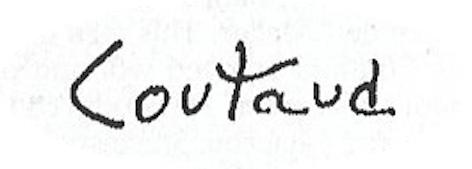

(Meynes, 1904 – Paris, 1977)

The son of a provencal goldsmith, Lucien Coutaud studied at the Beaux-Arts Academy in Nîmes from 1920, where he was a student of Armand Coussens, an excellent engraver who probably introduced Coutaud to the techniques of printmaking. He moved in Paris in 1924, where he attended the free academies of Montparnasse. Here, he meets the writer Marc Bernard.
The young Coutaud was interested in the Louvre Primitives, but also in the works of Chirico, Max Ernst and Paul Klee. In 1925, he met André Fraigneau for whom he illustrated Spectacles, his first book published by Jo Fabre. He was then admitted to the Ecole des Arts Décoratifs in the same year. In 1926, on the advice of Andre Salmon, he met Charles Dullin who asked him to make the sets and costumes of The Birds, Aristophanes's play, adapted by Bernard Zimmer. By the end of the year he was called to military service, first in Saint Cloud, and then in Mainz in the Rhineland.
The stay he made in 1927 on the banks of the Rhine, far from his native Provence, allowed him to leave behind the principles that were taught to him at the Beaux-Arts, allowing him to adopt a personal pictorial language, characterized by landscapes in gray-blue shades and with a very soft light.
In April 1928, he returns to Paris and in 1929 painted his first important paintings: La Bicyclette, Female and Soldier, Soldiers arresting a spy, Young Girl with three wheels. In 1930 he produced his first etchings, drypoint on zinc : Rhineland Souvenir, Three Amazons, The Cyclist, The Morning. During this time, he enters into relationship with the writer Jean Blanzat.
In 1931, the Quatre Chemins gallery in Paris organized his first solo exhibition. In 1932, he worked almost exclusively with gouache, painting many bouquets of flowers and large esoteric compositions. He also created stage sets and costumes for Le Chateau des Papes of André de Richaud directed by Charles Dullin at the Théâtre de l'Atelier and for Venus and Adonis by André Obey directed by Michel Saint-Denis and presented by the Compagnie des Quinze. He is interested by the surrealist group activities, reading Breton, Soupault, Aragon as well as many others; nevertheless he did not engage with the group because he wanted to keep his independence.
He attended many events of the avant-garde group, alongside the surrealists without really joining the group, a group dedicated to an art that he described as "surreal" since 1940. During these years he affirms his graphic style, one that is close to surrealism, through the use of an unusual imaging where dreams and reality intertwine.
The period of the Second World War was a period of great depression for the artist, as he became overwhelmed by a loathing of humanity due to the development of diabetes that will make him suffer all his life. It is a dark period for Coutaud, compounded by illness and questions about his identity. The characters represented in his paintings lose their flesh, are reduced to the state of skeletons, then fragmented and deprivated of faces in the manner of mannequins or robots, only retaining their sexuality to keep a track of humanity. Recovered, Coutaud created sets and costumes for the theater, tapestries and revisits engraving.
In 1948, after the death of his father, Coutaud discoveres the coast of Brittany by traveling to Belle-Ile-en-Mer. He then settled near the Channel in 1952 in a house he called the "brick horse", which became one of his main sources of inspiration.
His figurative style, evolving into oneiric abstraction, is close to surrealism, presenting with southern colors the bullfighting poetry, the drama of death. This painter-poet who was a friend of Jean Blanzat, Fraigneau, Marc Bernard, Jean-Louis Barrault, Oscar Dominguez, Paul Eluard, Picasso, Jacques Prévert, Boris Vian, Gilbert Lely, Jean Paul Sartre, Yves Tanguy, and Félix Labisse never ceased to assert his independence. Lucien Coutaud invented Éroticomagie, which is a painting of a world centered on an individual and his metamorphosis, but always with a sexual connotation, as we see in the impressive series of "Taureaumagies" or the "Swans-People". The Éroticomagie is a carnal and dreamlike fusion of Eros and magic, a reflection of his inner world.
The painter's world, which he shows through his paintings of dream fragments is completed step by step, and over time. The artist indeed painted various subjects that populated his imagination: "Characters, vegetable and mineral houses, metamorphoses, large tracts of land and irons." He then appropriates these issues and transposes them into another poetic reality.